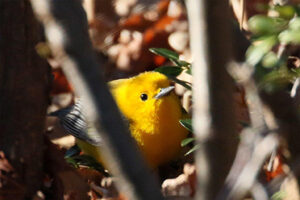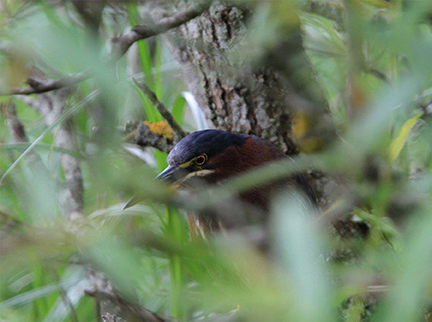A Birder’s Story
By Robert Culbert

Prothonotary warbler, Photo by Lanny McDowell
When I am in downtown Edgartown and have an extra half hour, a visit to Sheriff’s Meadow Sanctuary relaxes me. The peace and quiet reset my mind, and there are ducks, herons, terns, hummingbirds, owls, thrushes, warblers, and sparrows to find. The trail loops around the pond, and traverses several shrub swamps; one never knows what might be seen.
A couple of springs ago the brightest yellow bird I have ever seen popped up to the top of a shrub in front of me; the prothonotary warbler—an uncommon sighting on the Island—stayed there long enough for me to observe it through my binoculars before it dropped down back into the thicket never to be seen again.
Ruby-throated hummingbirds are found from April to October. I search for flowers, especially red or orange ones, as those are their preferred colors. If it is August or September, I look in the shrub swamps for the orange jewelweed flowers (touch-me-nots, with their seed pods that explode when touched). Jewelweed grew into an area several weeks after it was cleared of invasive shrubs. For more than one week there were six or eight hummers flying from flower to flower drinking nectar and pollinating the flowers.
From spring to fall, just about anywhere on the property I hear what sounds like somebody scuffling through the brush and leaves, but nobody is there. This is the eastern towhee, one of the most common birds on the Island. I look for them on the ground, where they find their food by noisily kicking the leaf litter aside and consuming the unexpectedly visible bugs. Listen for their song: “Drink your tea-ea-ea-ea!”
I enjoy the pine woodlands where pine needles are often the only thing covering the ground in the understory. The action here is up in the tree-tops, with black-capped chickadees, white-breasted nuthatches, tufted titmice, and red-bellied woodpeckers all seen regularly. Yes, they are common birds, but I take time to watch their antics. I hear them calling and then try to find them. Can you see the chickadee hanging upside down at the tip of the branch? Or a nuthatch climbing head first down the tree trunk? Do not forget to look for other insect-eating birds that may be mixed in with these year-round residents.
Barred owls, a species new to the island, have been year-round residents of this property for two years. Despite repeated searches, I have yet to find their nest or where they perch. Maybe you can find this; look for whitewash on tree trunks or the ground, or regurgitated pellets on the ground. Then look up into the tree overhead. If you do find them, congratulations! Enjoy the view, but please avoid sudden motions and be extra quiet in that area, and let me know what you found!
But the pond is the most fascinating for me. There are four different places where you can have open views of the pond; I visit all of them because different parts of the pond shoreline are visible from each. Often black-crowned night-herons or green herons are perched in the dead tree to the left of the southern pond access. And a belted kingfisher may be noisily flying around, or maybe it is perched on a dead branch hanging over the water, waiting for some unsuspecting fish to swim too close.

Green heron
I visit this property every week in the summer, and last year I watched from across the pond as a pair of green herons built a nest, incubated their eggs, and then tended the hatchlings as they grew to be gangly youngsters too big for their stick nest. My last sighting of this family was of one of the two fledglings flying across the pond.
My favorite spot is on the bridge over the dam that creates the pond. The sound of the water gurgling its way over the dam is very relaxing. Here we are treated to views of a cove on the opposite shoreline of the pond, a part of the shoreline that is not visible from any of the other access points. There are often ducks in that cove, maybe even a secretive pied-billed grebe in the fall.
Looking north from the bridge gives you views of tidal John Butler’s Mud Hole, Eel Pond, Little Beach, and a distant Cape Poge. In the summer there are terns swarming over their nesting colony on Little Beach; some may fly closer as they hunt for and plunge dive into the water to catch their food. Or maybe several least terns will land on the pond to swim, bathe, and drink fresh water. Five or six loud American oystercatchers may be heard as they fly around Eel Pond socializing.
The peace and quiet relaxes me in the middle of downtown Edgartown. And one never knows what avian surprises might be around the next corner of the trail; here I have presented a few examples of the wide variety of species that may be found in the diverse habitats of this small sanctuary.
Robert Culbert is an ecological consultant with Nature Watch LLC, a birder on Martha’s Vineyard for more than 40 years, and the author of the Vineyard Gazette’s weekly Bird News column. He lives in Vineyard Haven.
Photo by Lanny McDowell

